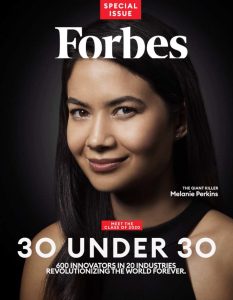Melanie Perkins, co-founder and CEO of Canva, is a shining example of how passion, persistence, and vision can turn a simple idea into a billion-dollar enterprise. Her journey from a university student with a startup idea to leading one of the world’s most successful design platforms is nothing short of inspirational.
Early Beginnings: The Birth of an Idea
 Melanie Perkins, was born in Perth, Australia, in 1987. Her entrepreneurial spirit was evident early on. At the age of 19, while studying at the University of Western Australia, Perkins noticed a significant gap in the market for design tools. At the time, creating professional-looking designs required expensive software and a steep learning curve, something that many students and small business owners couldn’t afford or navigate easily. Perkins, alongside her then-boyfriend (now co-founder) Cliff Obrecht, realized that design should be accessible to everyone, regardless of their technical skill level. This realization led to the creation of Fusion Books in 2007, an online tool that allowed students and schools to create and print their own yearbooks. Fusion Books was essentially the prototype for what would later become Canva. The platform was simple, user-friendly, and allowed anyone to create something visually appealing without needing to be a design expert.
Melanie Perkins, was born in Perth, Australia, in 1987. Her entrepreneurial spirit was evident early on. At the age of 19, while studying at the University of Western Australia, Perkins noticed a significant gap in the market for design tools. At the time, creating professional-looking designs required expensive software and a steep learning curve, something that many students and small business owners couldn’t afford or navigate easily. Perkins, alongside her then-boyfriend (now co-founder) Cliff Obrecht, realized that design should be accessible to everyone, regardless of their technical skill level. This realization led to the creation of Fusion Books in 2007, an online tool that allowed students and schools to create and print their own yearbooks. Fusion Books was essentially the prototype for what would later become Canva. The platform was simple, user-friendly, and allowed anyone to create something visually appealing without needing to be a design expert.
Fusion Books started small, but it quickly gained traction in Australia, expanding into France and New Zealand. The success of Fusion Books gave Perkins the confidence to think bigger. She envisioned a world where design was accessible to everyone, not just students creating yearbooks, but businesses, marketers, and individuals across the globe. This vision laid the foundation for Canva.
The Challenges of Startup Life:
Starting a business is never easy, and Perkins faced her fair share of challenges. In the early days, the biggest obstacle was securing funding. Despite the success of Fusion Books, investors were skeptical about the potential of Canva. The idea of democratizing design seemed too ambitious, and many investors didn’t see the need for such a platform. Perkins and Obrecht pitched their idea to over 100 investors, facing rejection after rejection.
 However, Perkins was undeterred. She believed in her vision and knew that with the right support, Canva could revolutionize the design industry. Her persistence paid off when she connected with Bill Tai, a prominent Silicon Valley venture capitalist. Tai was impressed with Perkins’ determination and saw potential in her idea. He introduced her to Cameron Adams, a former Google engineer, who would later become Canva’s third co-founder.
However, Perkins was undeterred. She believed in her vision and knew that with the right support, Canva could revolutionize the design industry. Her persistence paid off when she connected with Bill Tai, a prominent Silicon Valley venture capitalist. Tai was impressed with Perkins’ determination and saw potential in her idea. He introduced her to Cameron Adams, a former Google engineer, who would later become Canva’s third co-founder.
With Adams on board and a solid team in place, Perkins and her team continued to refine Canva’s platform. They focused on making it as user-friendly as possible, ensuring that anyone, regardless of their design experience, could create professional-quality designs. This focus on simplicity and accessibility became one of Canva’s defining features.
Launching Canva: A Global Success Story
Canva officially launched in 2013, and it quickly gained popularity. Within its first year, Canva had over 750,000 users. The platform’s success was driven by its ease of use, a vast library of templates, and its freemium business model, which allowed users to access basic features for free while offering premium features at a reasonable cost. Canva’s growth was meteoric. By 2015, the platform had reached 5 million users, and by 2017, it had over 10 million users in 179 countries. The company’s valuation soared, and it attracted high-profile investors, including Guy Kawasaki, who became Canva’s Chief Evangelist. Perkins’ vision of democratizing design was becoming a reality.

A key factor in Canva’s success was its ability to stay ahead of the curve. As the platform grew, Perkins and her team continually added new features and expanded Canva’s offerings. They introduced Canva for Work in 2015, targeting businesses and teams, followed by Canva Pro and Canva for Enterprise, which provided more advanced features and collaboration tools. Canva also expanded into new markets, offering its platform in multiple languages and launching Canva Print, allowing users to print their designs on various products.
Perseverance Through Challenges
Like any global company, Canva faced its share of challenges. Scaling a platform to millions of users requires significant resources, and Canva needed to ensure that its infrastructure could handle the growing demand. The company also had to navigate the complexities of entering new markets, dealing with different regulations, and addressing the diverse needs of its users. However, Perkins’ leadership and the strong company culture she fostered helped Canva overcome these challenges. She emphasized the importance of maintaining a positive work environment, where creativity and innovation could thrive. Perkins also focused on giving back, with Canva committing to donating 1% of its equity, profit, time, and resources to improve the world through the Canva Foundation.
Canva’s Impact on the World
 Today, Canva is a global powerhouse, with over 75 million active users creating more than 1 billion designs each month. The platform has revolutionized the way people approach design, making it accessible to everyone, from individuals creating social media posts to businesses developing marketing materials. Canva’s success has not only made Perkins one of the youngest female billionaires in the world but has also had a significant impact on the startup ecosystem. Perkins’ journey has inspired countless entrepreneurs, particularly women, to pursue their ideas and overcome the challenges of startup life. She has proven that with persistence, passion, and a clear vision, it’s possible to turn a simple idea into a global success. Canva’s influence extends beyond design. The platform has become a tool for empowerment, enabling people to express their creativity and communicate their ideas visually, regardless of their background or experience. This democratization of design has leveled the playing field, allowing small businesses and individuals to compete with larger companies in terms of visual content and branding.
Today, Canva is a global powerhouse, with over 75 million active users creating more than 1 billion designs each month. The platform has revolutionized the way people approach design, making it accessible to everyone, from individuals creating social media posts to businesses developing marketing materials. Canva’s success has not only made Perkins one of the youngest female billionaires in the world but has also had a significant impact on the startup ecosystem. Perkins’ journey has inspired countless entrepreneurs, particularly women, to pursue their ideas and overcome the challenges of startup life. She has proven that with persistence, passion, and a clear vision, it’s possible to turn a simple idea into a global success. Canva’s influence extends beyond design. The platform has become a tool for empowerment, enabling people to express their creativity and communicate their ideas visually, regardless of their background or experience. This democratization of design has leveled the playing field, allowing small businesses and individuals to compete with larger companies in terms of visual content and branding.
An Example for Others
Perkins’ story is a testament to the power of entrepreneurship. From her humble beginnings in Perth to leading a multi-billion-dollar company, she has shown that with determination and a clear vision, anything is possible. As Canva continues to innovate and expand, it will undoubtedly remain a key player in the global design landscape for years to come. As Canva continues to grow, it serves as a powerful example of what can be achieved when passion meets persistence.








